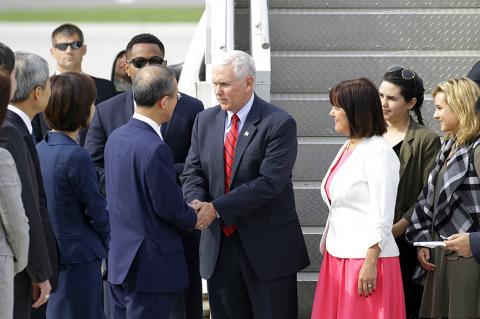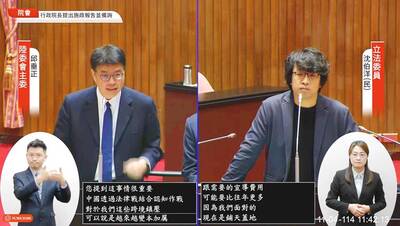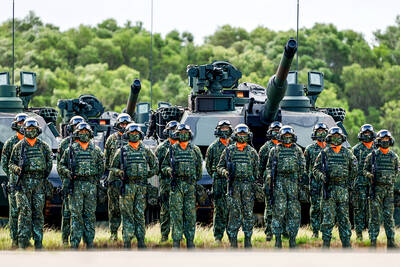A North Korean missile “blew up almost immediately” yesterday on its test launch, the US Pacific Command said, hours before US Vice President Mike Pence landed in South Korea for talks on the North’s arms program.
The failed launch from North Korea’s east coast, ignoring repeated admonitions from major ally China, came one day after the North held a grand military parade in its capital, marking the anniversary of the birth of its founder, displaying what appeared to be new long-range ballistic missiles.
US President Donald Trump yesterday acknowledged China’s help with the North Korean issue, linking it to a softer line taken on China’s management of its currency.

Photo: Reuters
“Why would I call China a currency manipulator when they are working with us on the North Korean problem? We will see what happens!” Trump said on Twitter.
On the campaign trail last year Trump promised to label China in that way.
Chinese Minister of Foreign Affairs Yang Jiechi (楊潔篪), and US Secretary of State Rex Tillerson yesterday exchanged views on the “situation on the Korean Peninsula” by telephone, Xinhua news agency said, adding that Yang said the two sides should maintain dialogue.

Photo: Bloomberg
South Korea said the North’s combined show of force “threatened the whole world,” but a US foreign policy adviser traveling with Pence on Air Force Two appeared to defuse some of the tension, saying the test of what was believed to be a medium-range missile had come as no surprise.
“We had good intelligence before the launch and good intelligence after the launch,” the adviser told reporters on condition of anonymity. “It’s a failed test. It follows another failed test. So really no need to reinforce their failure. We don’t need to expend any resources against that.”
The adviser said the missile’s flight lasted four or five seconds.
“It wasn’t a matter of if, it was a matter of when. The good news is that after five seconds it fizzled out,” the adviser said.
Pence is in Seoul at the beginning of a 10-day trip to Asia in what his aides said was a sign of US commitment to its ally in the face of rising tension.
South Korea, which hosts 28,500 US troops, had warned of punitive action if yesterday’s launch led to further provocation.
“North Korea showing a variety of offensive missiles at yesterday’s [Saturday] military parade and daring to fire a ballistic missile today is a show of force that threatens the whole world,” the South Korean Ministry of Foreign Affairs said in a statement.
Pence, addressing an Easter service with US troops, said the US commitment to South Korea was unwavering, adding: “Let me assure you under President Trump’s leadership, our resolve has never been stronger. Our commitment to this historic alliance with the courageous people of South Korea has never been stronger.”
In Washington, US National Security Advisor H. R. McMaster said that the US was working with China and other allies to develop a range of options on North Korea, which he called “a hostile regime.”
He said that all options were on the table.
Saturday’s parade combined with yesterday’s failed missile launch made a sixth nuclear test increasingly likely, and if one was carried out, China would be compelled to support new sanctions against North Korea, the Global Times, an influential tabloid published by the Chinese Communist Party said in an editorial.
Meanwhile, in Pyongyang, there was a festive atmosphere at a flower show, with families out taking pictures. There was no mention of the test failure by the official Korean Central News Agency.

CALL FOR SUPPORT: President William Lai called on lawmakers across party lines to ensure the livelihood of Taiwanese and that national security is protected President William Lai (賴清德) yesterday called for bipartisan support for Taiwan’s investment in self-defense capabilities at the christening and launch of two coast guard vessels at CSBC Corp, Taiwan’s (台灣國際造船) shipyard in Kaohsiung. The Taipei (台北) is the fourth and final ship of the Chiayi-class offshore patrol vessels, and the Siraya (西拉雅) is the Coast Guard Administration’s (CGA) first-ever ocean patrol vessel, the government said. The Taipei is the fourth and final ship of the Chiayi-class offshore patrol vessels with a displacement of about 4,000 tonnes, Lai said. This ship class was ordered as a result of former president Tsai Ing-wen’s (蔡英文) 2018

‘SECRETS’: While saying China would not attack during his presidency, Donald Trump declined to say how Washington would respond if Beijing were to take military action US President Donald Trump said that China would not take military action against Taiwan while he is president, as the Chinese leaders “know the consequences.” Trump made the statement during an interview on CBS’ 60 Minutes program that aired on Sunday, a few days after his meeting with Chinese President Xi Jinping (習近平) in South Korea. “He [Xi] has openly said, and his people have openly said at meetings, ‘we would never do anything while President Trump is president,’ because they know the consequences,” Trump said in the interview. However, he repeatedly declined to say exactly how Washington would respond in

WARFARE: All sectors of society should recognize, unite, and collectively resist and condemn Beijing’s cross-border suppression, MAC Minister Chiu Chui-cheng said The number of Taiwanese detained because of legal affairs by Chinese authorities has tripled this year, as Beijing intensified its intimidation and division of Taiwanese by combining lawfare and cognitive warfare, the Mainland Affairs Council (MAC) said yesterday. MAC Minister Chiu Chui-cheng (邱垂正) made the statement in response to questions by Democratic Progressive Party (DPP) Legislator Puma Shen (沈柏洋) about the government’s response to counter Chinese public opinion warfare, lawfare and psychological warfare. Shen said he is also being investigated by China for promoting “Taiwanese independence.” He was referring to a report published on Tuesday last week by China’s state-run Xinhua news agency,

‘NOT SUBORDINATE’: Only Taiwanese can decide the nation’s future, and people preserving their democratic way of life is not a provocation, President William Lai said Taiwan does not want China’s “one country, two systems,” and must uphold its freedom and democracy as well as resolve to defend itself, President William Lai (賴清德) said yesterday, rejecting Beijing’s latest bid to bring the country under Chinese control. The president made the remarks while attending a commissioning ceremony for Taiwan’s first battalion of M1A2T Abrams tanks in Hsinchu County’s Hukou Township (湖口). The tanks are made by General Dynamics, a major US defense contractor. China this week said it “absolutely will not” rule out using force over Taiwan, striking a much tougher tone than a series of articles in state media